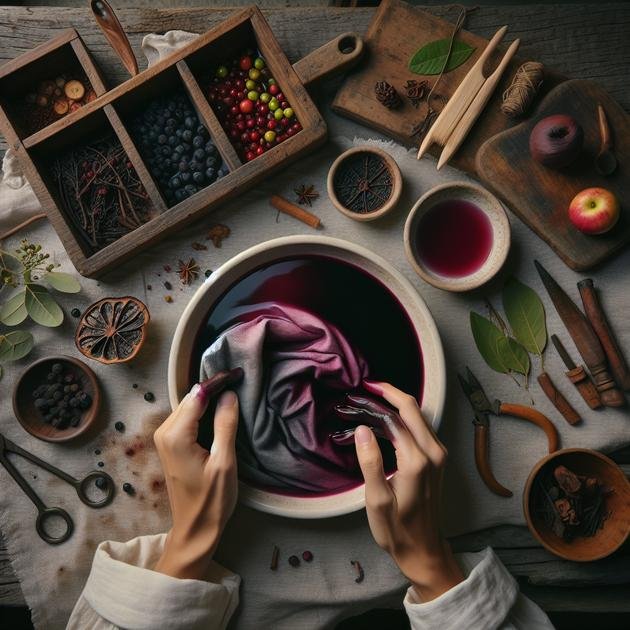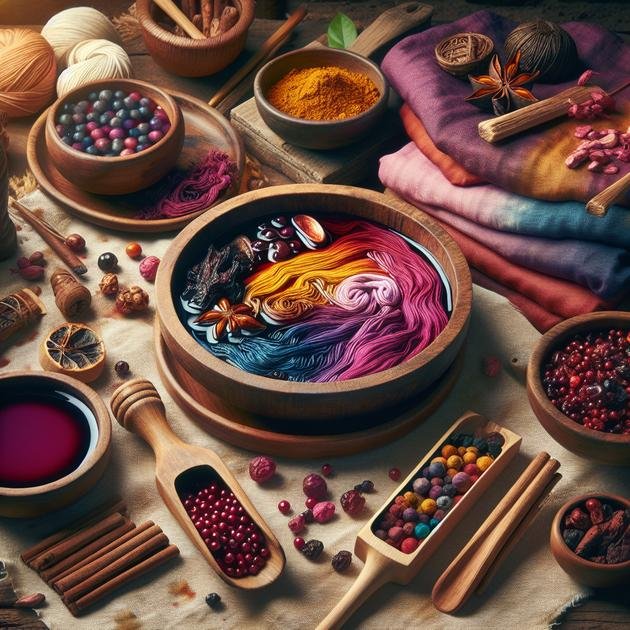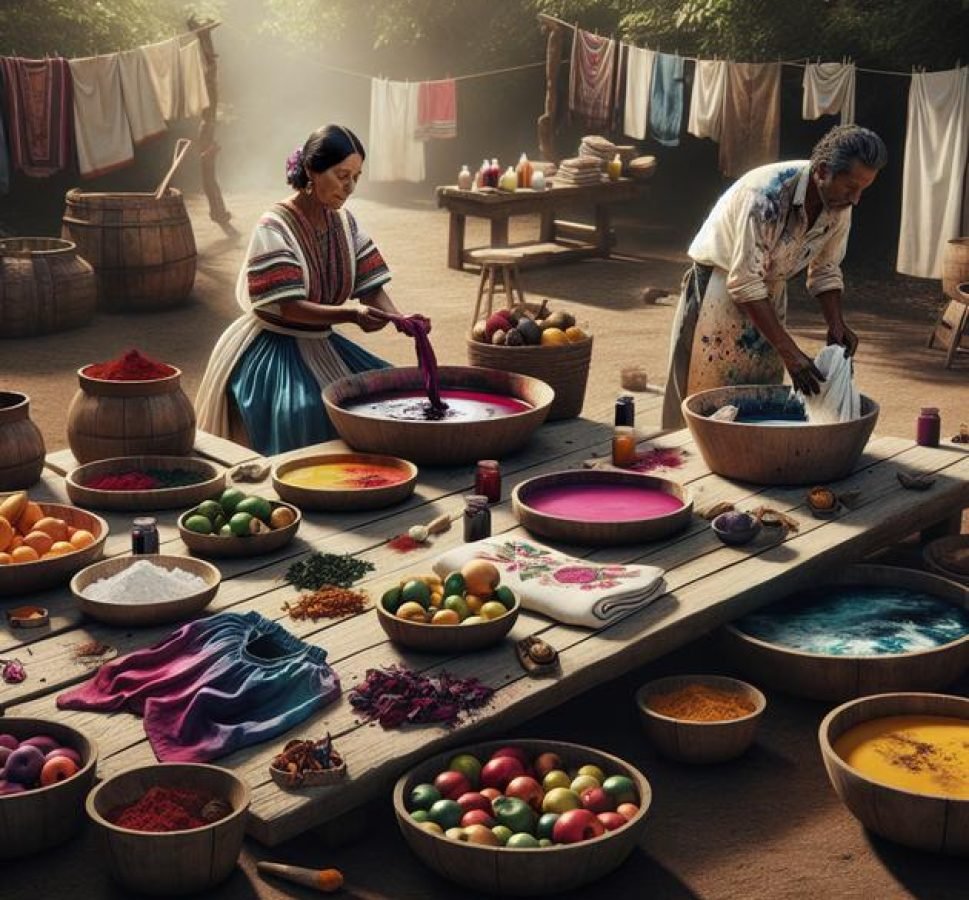Natural dye fabrics use kitchen ingredients like turmeric, onion skins, and beetroot to create eco-friendly, vibrant colors on natural fibers through a process of mordanting, dye extraction, and careful application.
Ever thought about how natural dye fabrics can add charm to your clothes using stuff from your kitchen? It’s simpler than you imagine, and a bit of experimentation can bring surprising, beautiful results. Ready to dive in?
understanding natural dye fabrics
Natural dye fabrics are textiles colored using dyes derived from plants, minerals, and other natural sources instead of synthetic chemicals. This method has been used for centuries and offers a sustainable and eco-friendly alternative to conventional fabric dyeing.
What Makes Natural Dyes Different?
Unlike chemical dyes, natural dyes come from renewable resources such as roots, berries, leaves, and bark. These dyes create unique, rich colors that vary depending on fabric type and mordants used.
Common Natural Dye Sources
Popular natural dye ingredients include turmeric for yellow, madder root for red, indigo leaves for blue, and walnut shells for brown. Each provides a different shade and intensity, often richer and more varied than synthetic colors.
Benefits of Using Natural Dyes
Natural dye fabrics are biodegradable, non-toxic, and safer for both the environment and skin. They also allow for creative experimentation, producing one-of-a-kind patterns and hues not easily replicated by machine dyes.
choosing the right kitchen ingredients for dyeing
Choosing the right kitchen ingredients is key to successfully dyeing fabrics naturally. Many common household items can produce vibrant colors without harsh chemicals. Popular ingredients include turmeric, onion skins, and beets, each known for their ability to impart beautiful and lasting hues.
Turmeric for Bright Yellow
Turmeric powder or fresh roots create a bright yellow dye that works well on cotton and wool. It’s affordable and easy to extract.
Onion Skins for Warm Orange to Brown
Both red and yellow onion skins can be used to achieve shades ranging from subtle orange to a rich brown. Using dried skins intensifies the color.
Beets for Pink and Red Tones
Beetroot juice or slices provide lovely pink-to-red tones. Keep in mind that beet dyes may fade faster and are best for fabric that won’t be washed frequently.
Additional Kitchen Ingredients
Other options include coffee grounds for brown shades, black tea for tan colors, and spinach for green tones. Each ingredient requires specific preparation methods to maximize color release.
Consider Fabric Type
Natural fibers like cotton, linen, wool, and silk absorb these kitchen dyes better than synthetic fabrics. Preparing your fabric properly will enhance the results.
preparing fabrics for natural dyeing

Preparing your fabric correctly is essential for successful natural dyeing. Start by choosing natural fibers like cotton, wool, silk, or linen, as they absorb dyes better than synthetic fabrics.
Cleaning the Fabric
Wash the fabric thoroughly to remove oils, dirt, or sizing agents. Use mild soap and warm water, then rinse well. A clean fabric allows dyes to penetrate evenly.
Mordanting to Fix the Color
Mordants help bind the dye to the fabric, improving colorfastness and brightness. Common mordants include alum, iron, and tin. Alum is safe and widely used.
How to Mordant
Prepare a mordant bath by dissolving the mordant in water, then soak the fabric for about one hour at a gentle simmer. Always follow safety guidelines and use gloves when handling mordants.
Drying and Testing
After mordanting, rinse the fabric in cool water and let it dry. You can test a small piece first to check how well the fabric absorbs the dye and adjust your process if needed.
how to extract dyes from kitchen ingredients
Extracting dyes from kitchen ingredients is a simple yet important step in natural fabric dyeing. Most natural dyes need to be boiled or soaked to release their color effectively.
Preparation of Ingredients
Chop or crush your kitchen ingredients such as onion skins, beetroot, or turmeric to increase the surface area. This helps release more pigment during extraction.
Simmering the Dye Bath
Place the prepared ingredients in a large pot and cover them with water. Simmer gently for 30 minutes to an hour. Avoid boiling vigorously, which can weaken the colors.
Straining the Dye
Once the color is released, strain the plant material out using a fine mesh or cheesecloth, leaving a clear dye bath ready for fabric dyeing.
Adjusting Color Intensity
You can adjust the color depth by simmering longer or adding more dye material. Test your fabric in the dye bath to see if the shade meets your expectations before dyeing fully.
Cold Soak Method
For more delicate items or some ingredients like berries, soaking fabric and dye material in cold water for 24 hours can also extract color gently.
step-by-step natural dyeing process
Natural dyeing is a rewarding process that transforms ordinary fabric into vibrant, unique textiles. Follow these steps for the best results.
Step 1: Prepare the Fabric
Wash the fabric to remove any residues. Soak it in a mordant bath, such as alum solution, for about an hour to help the dye bind better.
Step 2: Prepare the Dye Bath
Simmer your chosen kitchen ingredients, like onion skins or turmeric, in water to extract the color. Strain the solids out to have a clear dye bath.
Step 3: Dye the Fabric
Place the pre-treated fabric in the dye bath. Keep it simmering gently and stir occasionally to ensure even coloring. The length of time depends on desired intensity, usually 30 minutes to an hour.
Step 4: Rinse and Dry
Remove the fabric and rinse it in cold water until it runs clear. Hang or lay flat to dry away from direct sunlight to preserve the color.
Step 5: Optional Color Fixing
For longer-lasting color, you can soak the dyed fabric briefly in a mixture of water and vinegar or salt.
fixing colors to make them last longer

Fixing colors is a crucial step in natural dyeing to ensure that the vibrant hues on your fabric last longer and remain colorfast. Without proper fixing, colors may fade or wash out easily.
What Is Color Fixing?
Color fixing, also known as mordanting or setting, helps bind the dye molecules to the fabric fibers. This process improves color retention and resistance to washing and sunlight.
Common Fixing Agents
Natural fixatives such as alum, vinegar, and salt are often used. Alum is the most popular mordant because it is safe and effective. Vinegar and salt are easy household items that act as color fixers, especially for plant-based dyes.
Using Alum as a Mordant
Before dyeing, soak the fabric in a solution of alum and water. This prepares the fibers to accept and hold the dye better. Typically, a 10% alum solution (relative to the fabric weight) is used.
Post-Dye Fixing with Vinegar or Salt
After dyeing, rinse the fabric and soak it in a cold water bath mixed with either vinegar (for bright colors) or salt (for darker shades). This helps seal the color into the fabric.
Tips for Better Colorfastness
Always cool rinse your dyed fabric gently and avoid harsh detergents. Dry fabrics in the shade to prevent fading from sunlight. Testing a small piece before full projects helps achieve the best results.
common mistakes and how to avoid them
Working with natural dyes can be rewarding, but beginners often make mistakes that affect the final result. Being aware of these can help you get the most from your dyeing projects.
Using synthetic fabrics
Natural dyes work best on natural fibers like cotton, linen, wool, and silk. Synthetic fabrics may not absorb the dye well, leading to dull colors.
Skipping the mordanting step
Not using a mordant or fixing agent can cause colors to fade quickly. Always prepare your fabric with a suitable mordant before dyeing.
Overheating the dye bath
Boiling the dye bath too hard can break down pigments and cause colors to lighten or change. Maintain a gentle simmer instead.
Not testing colors
Colors can vary based on fabric type, mordant, and dye concentration. Always test a small fabric piece first to check the shade and colorfastness.
Using fresh dye materials without preparation
Some ingredients require drying or chopping to release color fully. Follow recipes carefully to maximize dye extraction.
Ignoring safety precautions
Some mordants and plants can be hazardous. Use gloves, work in a well-ventilated area, and store chemicals safely.
Rinsing fabric with hot water
Rinsing dyed fabric in hot water can cause colors to bleed. Use cool or lukewarm water instead.
Not drying fabric properly
Sunlight can fade natural dyes quickly. Dry fabrics in the shade to maintain rich colors.
creative projects using naturally dyed fabrics
Utilizing naturally dyed fabrics opens up many creative possibilities. These unique textiles bring a distinct, handmade touch to various projects.
Making Custom Clothing
Use naturally dyed fabrics to create one-of-a-kind shirts, scarves, or dresses. The subtle color variations add charm and personality to any garment.
Home Decor Items
Create cushion covers, table runners, or curtains using your dyed fabrics. These items add warmth and an organic feel to your living space.
Quilting and Patchwork
Incorporate naturally dyed patches into quilts for vibrant, eco-friendly designs. Each patch tells a story with its unique color and texture.
Accessories and Bags
Design bags, wallets, or headbands with dyed fabrics. Their rich colors and natural origins make accessories stand out.
Art and Wall Hangings
Use fabric as a canvas for painting or embroidery. Naturally dyed textiles offer a beautiful background for artistic expression.
Gift Wrap and Cards
Wrap gifts in dyed fabric for a sustainable, elegant alternative to paper. Small fabric pieces can also be used to decorate handmade cards.
Revamping Old Clothes
Refresh worn-out clothes by dyeing them naturally, giving them new life and reducing waste.
Collaborative Crafting
Organize dyeing workshops or craft groups to share ideas and create with naturally dyed fabrics together.
Wrapping Up Natural Dyeing with Kitchen Ingredients
Natural dyeing is an easy and eco-friendly way to add unique colors to your fabrics using simple kitchen ingredients. With a little preparation and care, anyone can experiment and create beautiful, lasting textiles.
By understanding how to choose ingredients, prepare fabrics, extract dyes, and fix colors properly, you can enjoy the art of natural dyeing while reducing chemical use.
Let your creativity shine by using naturally dyed fabrics in various projects, from clothing to home decor. This sustainable practice not only benefits the environment but also gives your items a special, handmade touch.
Give it a try and discover the joy of transforming ordinary fabrics into colorful works of art naturally.





